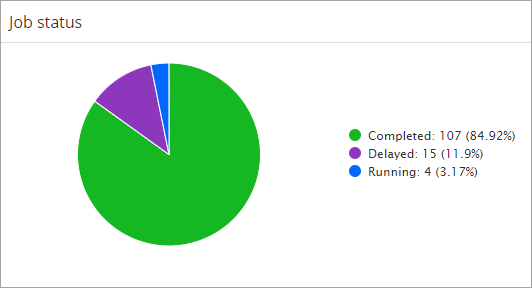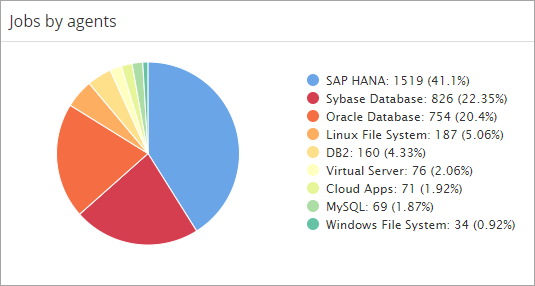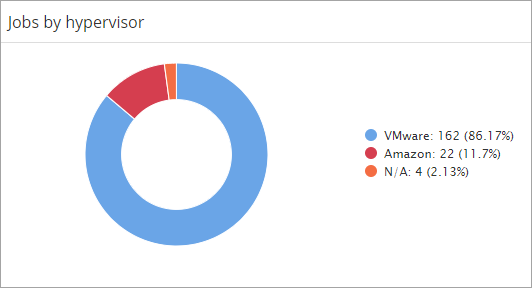This report displays information about all backup jobs completed for the entities that you specify, in the time period that you specify.
Job Status
This chart displays the number of backup jobs in each status during the specified time period. The percentage of jobs in each status is also displayed.

The following table defines each job status type.
|
Status |
Description |
|---|---|
|
Running |
Jobs that were running at the time of the report. |
|
Completed |
Jobs that completed during the specified time. |
|
Delayed |
Jobs that were delayed at the time of the report generation. |
|
No Run |
Jobs that are scheduled to run, but did not run which are in suspended state. Reasons that scheduled jobs do not run include:
|
|
Failed |
Jobs that failed. |
|
Killed |
Jobs that were killed. |
|
Completed with Errors |
Jobs that completed with errors. |
|
Completed with Warnings |
Jobs that completed with warnings. |
|
Committed |
Jobs that committed during the specified time. For more information about committing jobs, see Committing a Backup Job by Using the Kill Option. |
Jobs by Agents
This chart displays the number of agents installed in the CommCell environment.

Jobs by Hypervisor
This chart displays the number of each hypervisor type in the CommCell environment.

Summary
This table includes information about all backup jobs that ran during the specified time period.
|
Column |
Description |
|---|---|
|
Job Status |
The status of the job, such as Completed or Killed. |
|
Total Jobs |
The total number of jobs in this status. |
|
Size of Application |
The size of backup jobs in this status. |
|
Media Size |
The amount of storage media consumed by jobs in this status. |
|
Protected Objects |
The number of objects protected by jobs in this status. |
|
Failed Objects |
The number of objects that were not backed up by jobs in this status. |
|
Failed Folders |
The number of folders that were not backed up by jobs in this status. |
Job Details
This table includes information about each backup job that ran during the specified time period.
|
Column |
Description |
|---|---|
|
CommCell |
The name of the CommServe computer. |
|
Job ID |
The identifier that was assigned to the backup job. |
|
Server |
The name of the client computer where the backup job ran. |
|
Client ID |
The ID for the server. |
|
Company |
The company associated with the client computer. |
|
Agent |
The type of agent where the backup job ran. |
|
Instance |
The name of the instance where the backup job ran. |
|
VM Hypervisor Type |
The vendor name of the hypervisor where VMs are located. |
|
Backup Set |
The name of the backup set where the backup job ran. |
|
Subclient |
The name of the subclient where the backup job ran. |
|
Type |
Type of job, such as Backup or Synthetic Full. |
|
Backup Type |
The type of backup job, such as Full or Incremental. |
|
MediaAgent |
The MediaAgent that was used to move the backup to storage. |
|
Backup Window |
The day when the backup is configured to run. |
|
Start Time |
The date and time when the backup job initiated. |
|
End Time |
The date and time when the backup job stopped. |
|
Duration (mins) |
The amount of time the job ran. |
|
Application Size |
The amount of data that was included in the backup job. |
|
Media Size |
The amount of media that was consumed by the backup job. |
|
Storage Policy |
The storage policy associated with the subclient. |
|
Network Size |
The size of network used for the backup. |
|
Protected Objects |
The number of protected objects in the backup job. For Windows and UNIX File System agents, only files are counted as objects. Folders and directories are not counted as objects. |
|
Failed Objects |
The number of objects that failed to back up during the job. For Windows and UNIX File System agents, only files are counted as objects. Folders and directories are not counted as objects. |
|
Failed Folders |
The number of folders that failed to back up during the job. |
|
Job Status |
The status of the backup job such as Completed, Killed, or Failed. |
|
Dedup Savings (%) |
The percentage of data that was saved through deduplication. |
|
Server Groups |
The server group that the client computer belongs to. |
|
Failure Reason |
If applicable, reason that the job failed. |
|
Sync Source Files and Backup Index |
An indication of whether the option Sync Source Files and Backup Index is enabled on the subclient. |
|
Throughput (GB/Hour) |
The amount of data throughput in gigabytes per hour. |
|
VM Backup Size |
The size of the virtual machine backup |
|
VM Guest Size |
The amount of used space in the volumes on the virtual machine. |
|
Proxy |
The VM proxy. |
|
VM Guest Tools |
For VMware instances, the version of the VMware Tools software that is installed on the virtual machine. For Hyper-V instances, the version of the Integration Services software installed on the virtual machine. |
|
VM CBT Status |
Indicates whether the journal was used to identify data blocks that changed since the last incremental backup. |
|
VM GUID |
The ID for the VM. |
|
VM Host |
The machine that hosts the VM. |
|
VM Datastore |
The datastore where the VM disk is located on a storage array. |
|
Virtualization Client |
The client that you use to initiate backup operations and restore operations. |
|
Virtual Server |
The server where the virtual machines are located. |
|
Parent Job ID |
The ID of the original backup job that is used to create additional backup copies. |
|
Retain Data Until |
The final date that data is retained. |